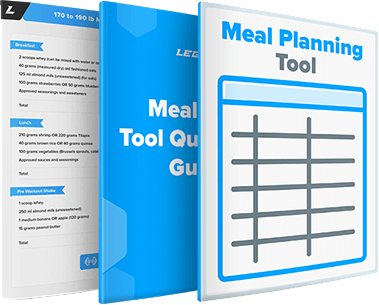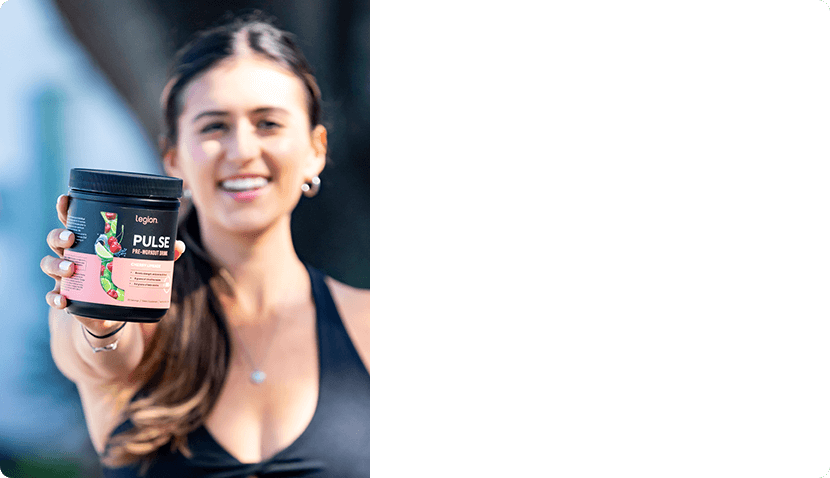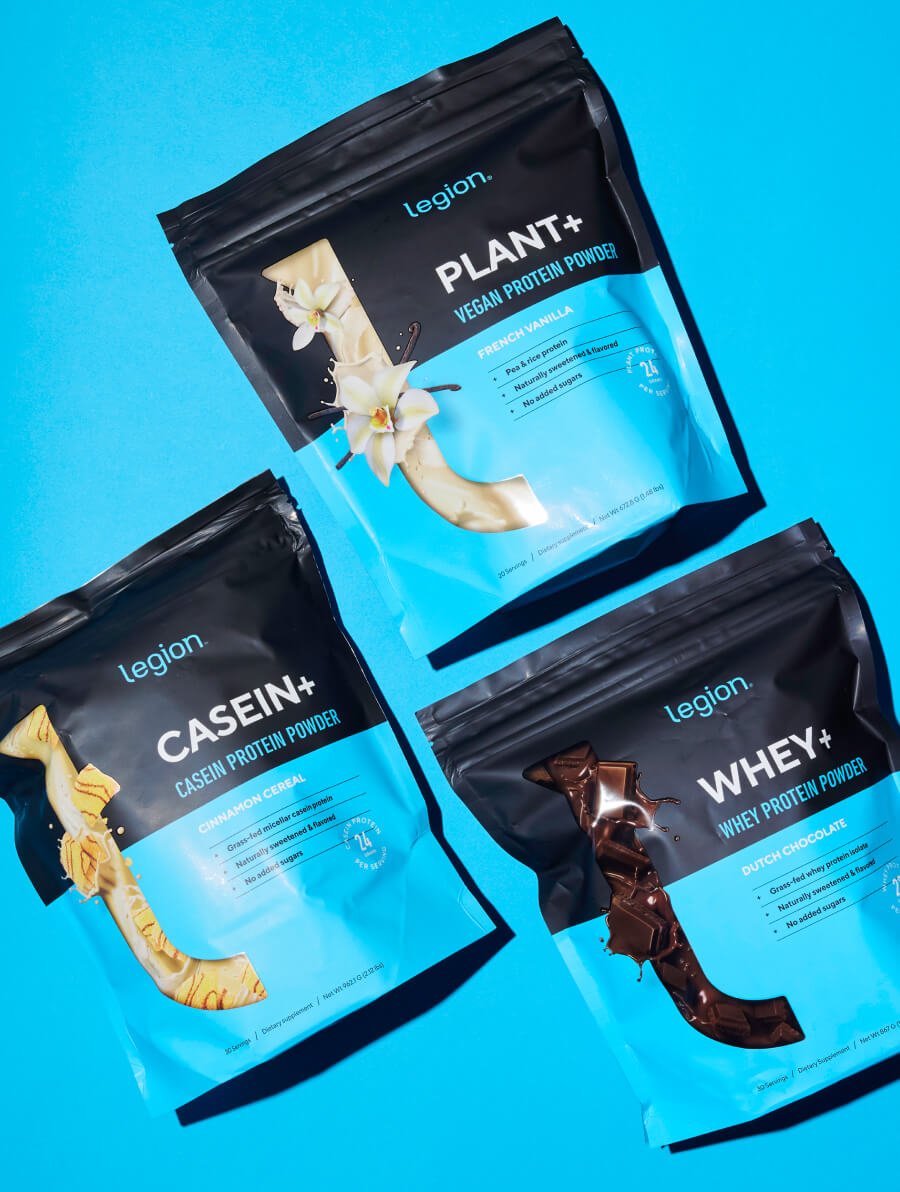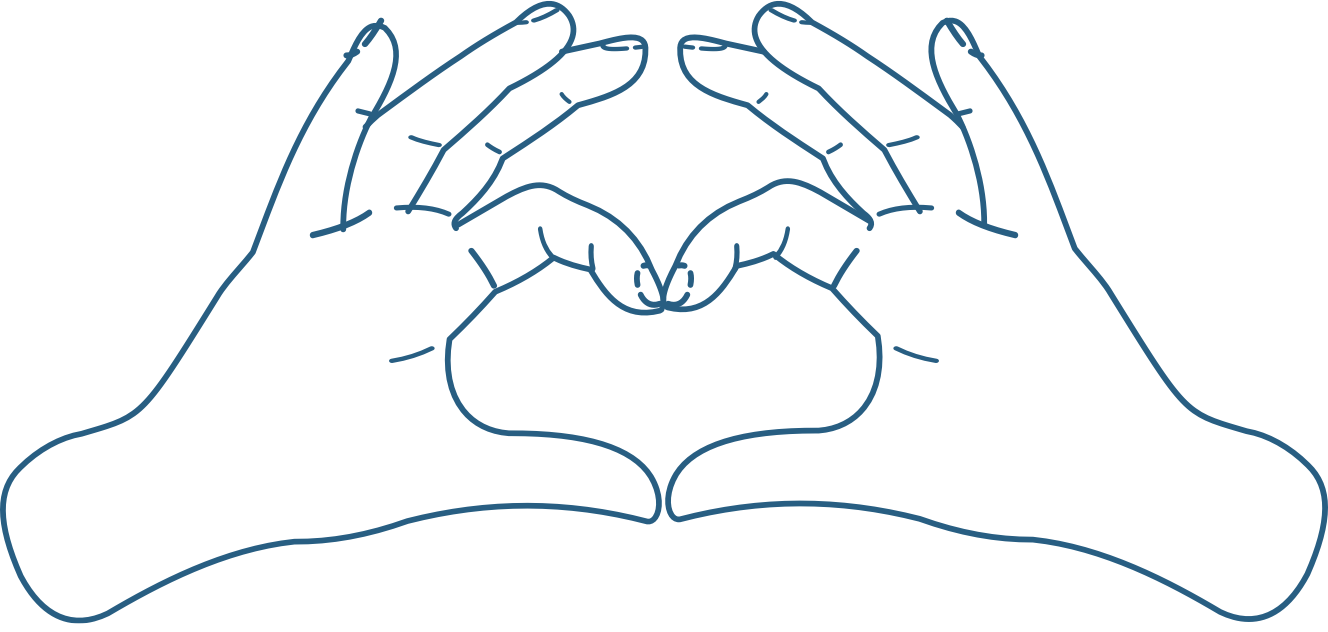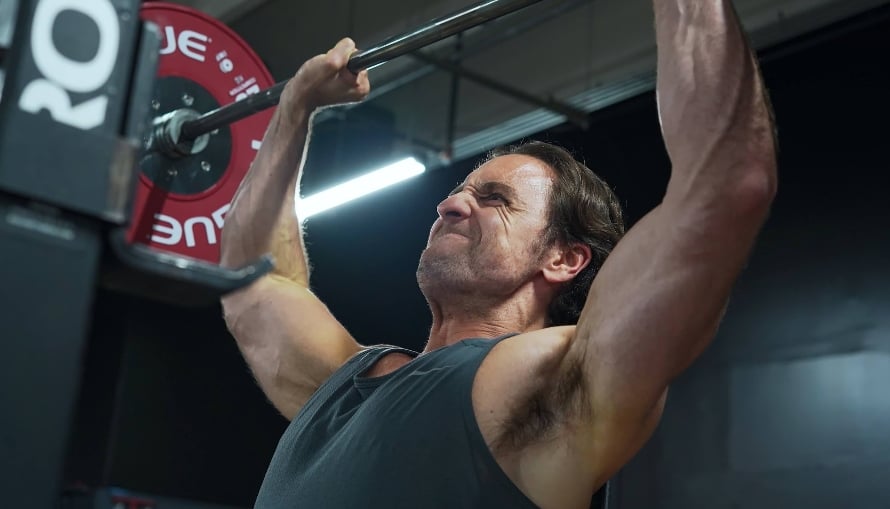
Most people do back and shoulder workouts on separate days—and that’s fine.
But if you want to build broad shoulders, wide lats, and a thick back as quickly as possible, combining them in the same workout might be even better.
Why?
Back exercises train your “pulling” muscles, while shoulder exercises target your “pushing” muscles, so you can pair them in the same workout without one interfering with the other.
This saves time and lets you train both muscle groups more often, which usually leads to faster growth.
The only challenge is programming your workouts properly. Get the balance wrong and you risk overtraining one area and neglecting another, burning yourself out with too much training, or simply creating workouts that keep you in the gym for hours at a time.
In this guide, you’ll learn exactly how to structure back and shoulder workouts for maximum muscle and strength gain, and get an evidence-based routine you can start using right away.
Key Takeaways
- Training your back and shoulders together is highly effective because the exercises complement each other—what back exercises miss, shoulder exercises cover, and vice versa.
- These workouts emphasize your lats and delts, the muscles most responsible for a broad, “V-tapered” physique, and let you train both more often without overtraining.
- Doing two back and shoulder workouts per week works best. It allows you to hit each muscle group with 10–20 total weekly sets without burning out.
- To maximize growth, take your sets 1–2 reps shy of failure and aim to add weight or reps each workout.
- You don’t need supplements to build back and shoulder mass, but protein powder, creatine, and pre-workout can help you get there faster.
Table of Contents
+
Can You Train Your Back and Shoulders Together?
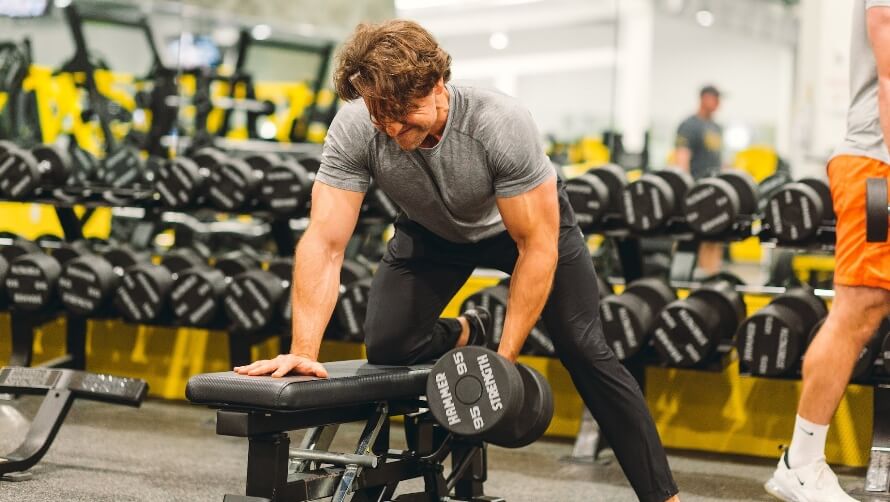
Yes—and for many people, it’s an excellent option. Back and shoulder workouts are less common than pairings like back and biceps (“pull”), chest and shoulders, or “push-pull,” but overlooking them is a mistake for several reasons:
Minimal Overlap Means Better Performance
Back exercises don’t train the same muscles as shoulder exercises and vice versa, so you can move from one to the other without fatigue from one limiting your performance on the next.
What’s more, because you’re not hammering the same muscles set after set, your workouts are easier to recover from. And when you recover well, you avoid the lingering soreness that can hinder performance in your next workouts.
All this matters because the harder you can train—the more weight you can lift and the more high-quality sets and reps you can perform—the better your results will be.
Complete Shoulder and Trap Development
Most compound shoulder exercises primarily train the front delts, with some work for the side delts but little for the rear delts. Back exercises, on the other hand, heavily involve the rear delts—so pairing the two ensures you train all parts of your shoulders in each workout.
It’s the same story with your traps. Rows, pull-ups, and pulldowns train your mid and lower traps, while overhead presses and upright rows hit your upper traps. Training your back and shoulders together, then, develops every part of the traps in every session.
You could argue that training your back and shoulders on separate days offers the same advantages—and technically, it does. But doing them together is more efficient, which leads us to the next benefit of shoulder and back workouts . . .
Train More Often (and Grow Faster)
Back and shoulder workouts make it easier to train both muscle groups twice (or even three times) per week, which research shows is better for muscle growth than training less often.
For instance, if you follow a “bro split” and train each muscle group separately, swapping your separate back workout and shoulder workout for two back and shoulder workouts increases how often you train these muscles, which—provided you manage workload and recovery—should boost your gains.
Perfect for Prioritizing Upper-Body Width
Your lats and delts are the two muscle groups most responsible for upper-body width. If your goal is to build a “V-taper look,” combining them into one focused workout—ideally done twice weekly—is an efficient way to prioritize it.
The Best Back and Shoulder Workout Routine for Mass & Width
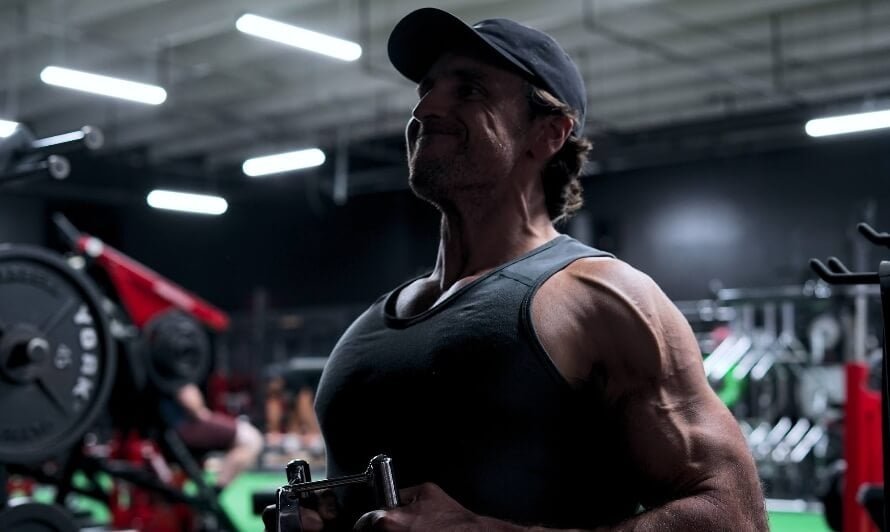
One back and shoulder workout per week won’t cut it—you simply can’t do enough quality sets for both muscle groups in a single session to maximize growth.
That’s why the best routines—including this one—split the work across two workouts per week.
This approach lets you train your entire back and shoulders with plenty of volume (sets) and variety—without overdoing it or slogging through marathon workouts.
Here’s the routine:
Legion Back and Shoulder Workout #1:
- Deadlift: 3–5 sets | 4–6 reps | 3–5 min rest
- Seated Shoulder Press: 3–5 sets | 4–6 reps | 3–5 min rest
- One-Arm Dumbbell Row: 3–5 sets | 6–8 reps | 2–3 min rest
- Barbell Upright Row: 3–5 sets | 6–8 reps | 2–3 min rest
Legion Back and Shoulder Workout #2:
- Overhead Press: 3–5 sets | 4–6 reps | 3–5 min rest
- Pull-up: 3–5 sets | 4–6 reps | 3–5 min rest
- Dumbbell Side Lateral Raise: 3–5 sets | 6–8 reps | 2–3 min rest
- Seated Cable Row: 3–5 sets | 6–8 reps | 2–3 min rest
Now that you know what the workouts look like, let’s break down what makes them effective. Specifically, we’re going to discuss exercise selection and order, and how the workouts balance volume, frequency, and intensity to maximize your back and shoulder gains.
Which Back and Shoulder Exercises Should You Do?
If your goal is maximum muscle growth, varying exercises is more important than varying rep ranges.
That’s because muscles develop most completely when you train them from multiple angles and through different ranges of motion.
This is especially true for your back and shoulders, which contain many muscles with different functions—and some with multiple distinct sections, or “heads.”
For example, here are all the muscles that make up your back:
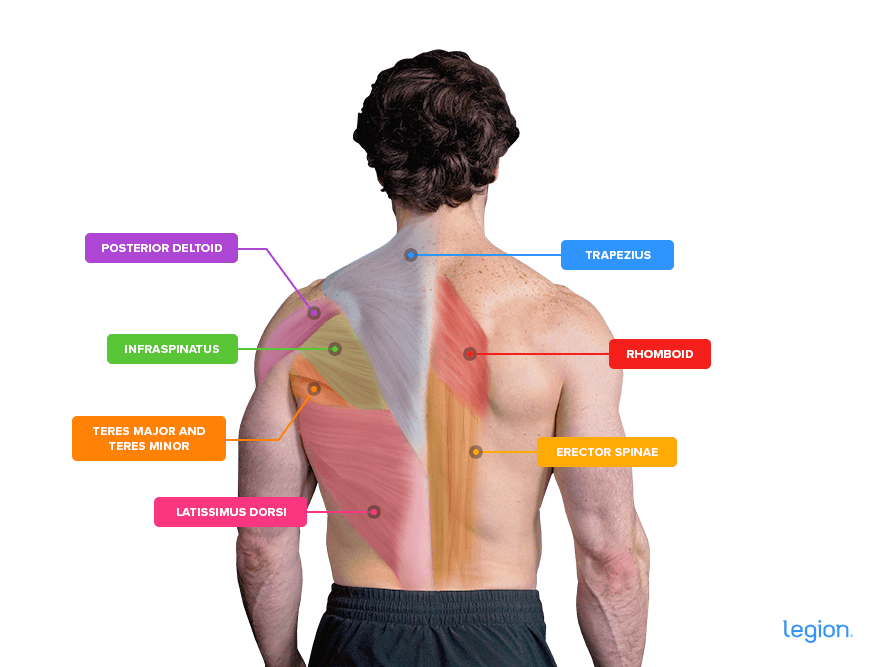
And here are the three heads that make up the deltoids (shoulder muscles):
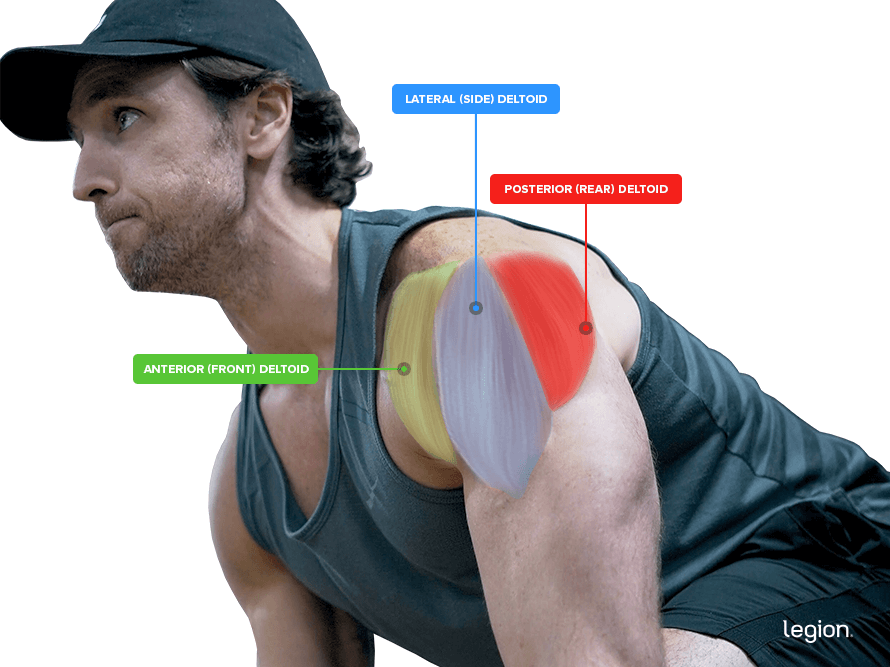
How much variety do you need, though?
Are three back and shoulder exercises enough? Or should you be doing four, five, or more?
Here are some practical guidelines:
- Two overhead pressing exercises per week are enough to build overall shoulder size and strength.
- For the rest of your shoulder training, focus on the side delts with exercises like side lateral raises.
- To train your entire back (including the rear delts), do one deadlift variation for overall size and strength, at least one “vertical pull” (pull-up, chin-up, or pulldown), and at least one “horizontal pull” (barbell, dumbbell, or cable row).
To prove this is enough, here are a few examples of guys who followed similar guidelines for just a few months through Legion’s body transformation coaching service. Their gains in shoulder and upper-back width speak for themselves:
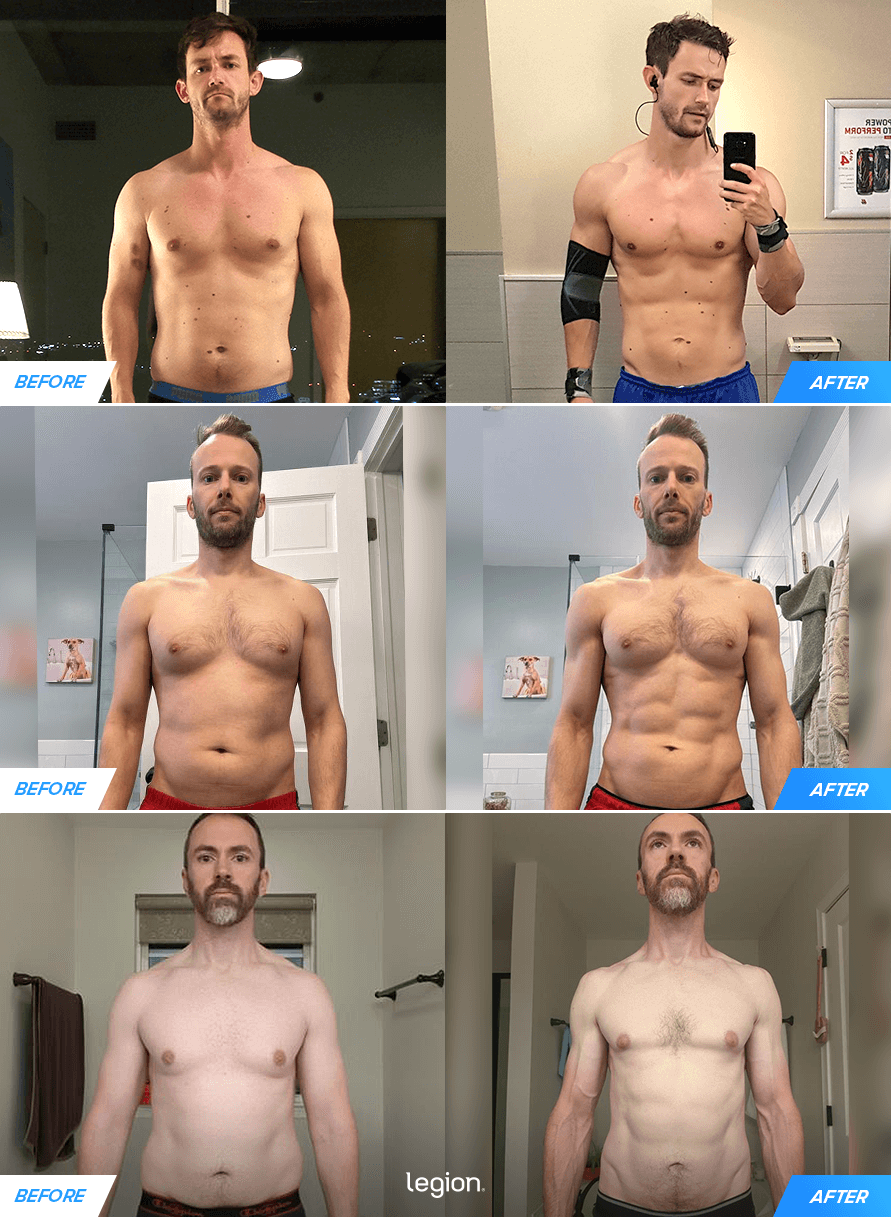
Should You Do Back or Shoulder Exercises First?
When you train your back and shoulders twice per week, start one workout with a back exercise and the other with a shoulder exercise. This balance ensures neither muscle group gets neglected.
Within each session, begin with the most demanding exercises—in this case, heavy deadlifts or overhead pressing—depending on which workout you’re doing. I explain why this is sensible in my best-selling fitness books for men and women, Bigger Leaner Stronger and Thinner Leaner Stronger:
No exercises will help you build a lean, muscular, and powerful body more than these, so you want to make sure you’re doing them every week, and you want to do them first in your workouts because they require the most physical and mental energy.
How Many Sets Should You Do?
To develop any muscle—your back and shoulders included—you need to train it with 10–20 weekly sets. Doing more might produce better results for some, but that’s the exception, not the rule.
It’s not just about how much you do, though, it’s also about how you distribute the work. Unpublished research suggests there’s a cap on how many sets you can do for a muscle group in a single workout before you hit diminishing returns—or even start doing more harm than good.
And that number seems to be around 6–10 sets per muscle group per workout.
As you can see in the graph below, muscle growth increases as you do more sets—up to a point—but then levels off and may even decline beyond about 10 sets.
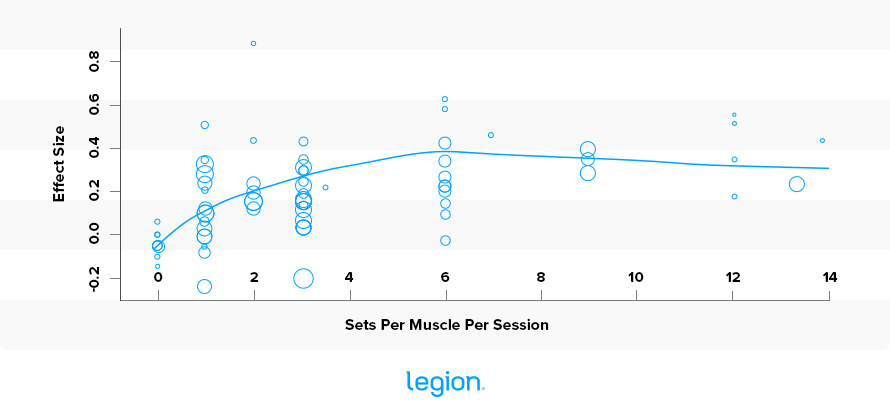
In other words, doing some volume is critical, but more isn’t always better. Once you cross that threshold, fatigue starts to outweigh the benefits, reducing how effectively your muscles can grow and recover between sessions.
So, the sweet spot is reaching 10–20 weekly sets without exceeding 6–10 sets for the same muscle group in one workout.
That’s why splitting your sets over two back and shoulders workouts each week makes most sense.
Here’s how to divide that volume based on experience level:
- If you’re a beginner, aim for the low end (10–15 sets per week).
- If you’re experienced, push toward the upper end (15–20 sets per week).
How Frequently Should You Train Your Back and Shoulders?
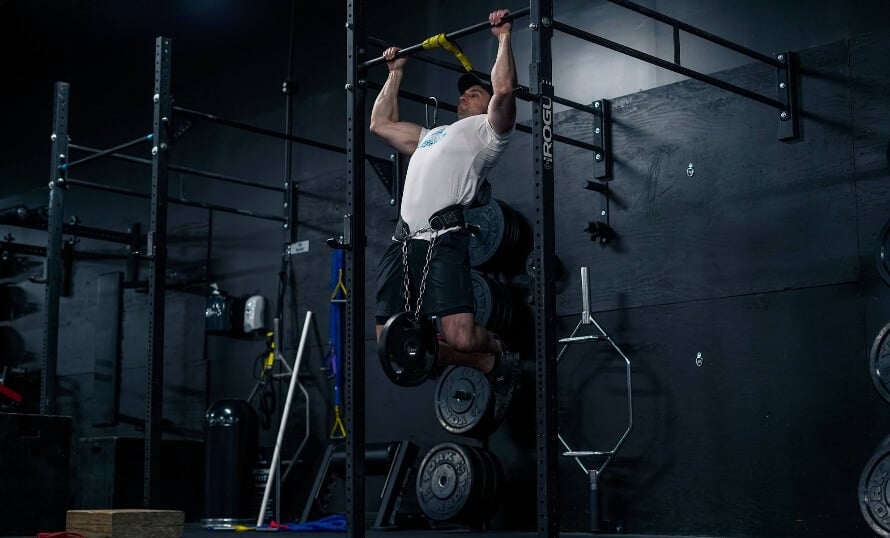
To get the best results possible, do each of the shoulder and back workouts once per week, leaving at least two days between them. Giving yourself a couple of days between these workouts allows your muscles to recover and ensures you’re ready to train them hard again in the next session.
For example, you could do Back and Shoulder Workout #1 on Monday, then Back and Shoulder Workout #2 on Thursday.
Here’s how this might look as part of a balanced weekly training split:
- Monday: Back and shoulders
- Tuesday: Chest
- Wednesday: Legs
- Thursday: Back and shoulders
- Friday: Arms
- Saturday: Rest
- Sunday: Rest
How Hard Should You Train?
Take most of the sets in your back and shoulder workouts 1–2 reps shy of “failure”—the point where you can’t perform another rep with proper form despite giving maximum effort.
To gauge whether you’re reaching this point, ask yourself at the end of each set: “If I had to, how many more reps could I have done with good form?” If the answer is more than two, increase the weight or reps on your next set to make it more challenging.
Training this way ensures you’re pushing your back and shoulder muscles hard enough to stimulate growth, but it’s only part of the equation. To keep building muscle and getting stronger, you also need to focus on progressive overload (gradually lifting heavier weights over time).
Here’s how to do it:
- If your workout calls for 4–6 reps of the deadlift and you complete 6 reps in a set, increase the weight by 10 pounds for your next set.
- If you do 3 reps or fewer in subsequent sets, reduce the load by 5 pounds to stay in the 4–6 rep range.
Apply this approach to every exercise in your back and shoulder workouts, aiming to add either weight or reps every session.
By combining the right intensity with progressive overload, you’ll consistently challenge your muscles, making each workout as effective as possible.
How Do You Warm Up?
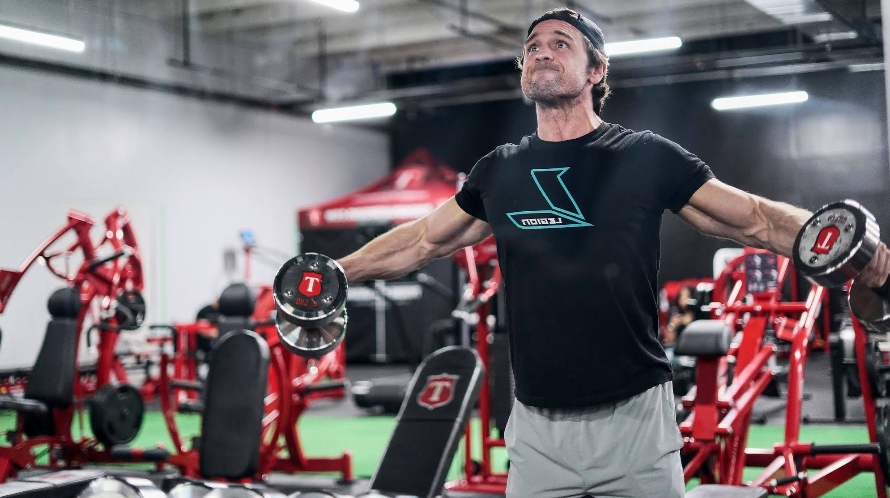
When you train multiple muscle groups in the same session, you often need to warm up each one separately, which takes extra time.
With back and shoulder workouts, though, there’s some overlap—your shoulders assist in many pulling exercises, and your back helps stabilize during pressing—so you don’t always need two full warm-ups.
With that in mind, here’s a solid approach:
- Estimate the weight you’ll use for your first hard set of your first exercise.
- Do 6 reps with about 50% of that weight and rest for 1 minute.
- Do 4 reps with about 70% of that weight and rest for 1 minute.
After this, you’re ready to tackle your hard sets for your first exercise.
Before your second exercise (the first for the other muscle group), you may want to do an additional warm-up set of 4 reps with about 70% of your “working” weight to groove in good form.
That said, if you feel good without it, just get started with your heavy weights for that exercise.
Do You Need Supplements to Gain Back and Shoulder Mass?
No, you don’t need supplements to build back and shoulder muscle. That said, the right ones can make the process easier. Here are three worth considering:
- Protein powder: Eating enough protein is essential for building and repairing muscle. Protein powders like Whey+, Casein+ and Egg+ make hitting your target easier.
- Creatine: Creatine boosts muscle and strength gain, improves anaerobic endurance, and reduces muscle damage and soreness. For a natural source of creatine, try Legion’s creatine monohydrate powder, creatine gummies, creatine capsules, or post-workout Recharge.
- Pre-workout: A quality pre-workout helps you train harder by boosting energy, focus, and athletic performance. Legion’s Pulse is available with or without caffeine.
Want even more specific supplement advice? Take the Legion Supplement Finder Quiz to learn exactly what supplements are right for you.
How to Do the Exercises in Your Back and Shoulder Workouts
Now let’s look at how to perform each exercise, why they’re the best choices, which muscles they train, and effective alternatives.
Deadlift
The deadlift is a horrible exercise for people who aren’t strength athletes,” said someone who was full of shit.
It’s actually hands-down the best exercise for building all-around back size and strength.
Why?
It trains your entire back—especially the spinal erectors, lats, traps, rhomboids, and teres major. And since so many large muscles work together, you can lift more weight than with any other back exercise and keep adding load consistently over time.
How to Do the Deadlift:
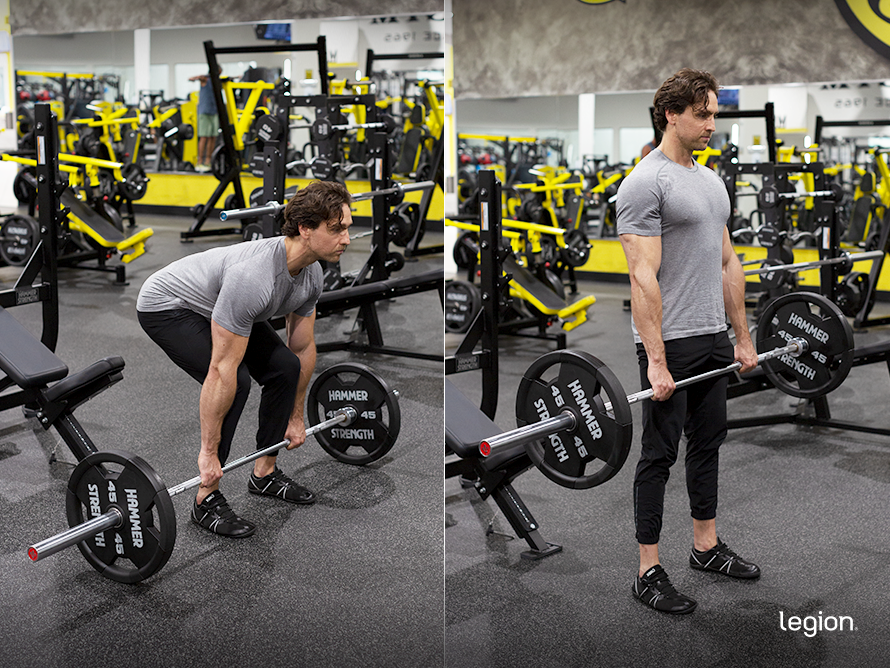
- Stand with your feet slightly narrower than shoulder width and your toes pointed slightly out.
- Position the bar over your midfoot about an inch from your shins.
- Push your hips back and grip the bar just outside your legs.
- Take a deep breath into your belly, brace your core, and flatten your back.
- Drive through your heels to stand up tall, keeping the bar close to your body.
- Reverse the movement and return to the starting position.
Muscles Worked: Erector spinae, rhomboids, traps, lats, teres major, glutes, hamstrings.
Alternatives:
Seated Shoulder Press
The seated shoulder press is an excellent follow-up to deadlifts because the bench supports your lower back, so you can press heavy weights safely without overloading the muscles you just worked.
Using dumbbells lets you lower the weight to the sides of your head instead of in front of your chest (as you have to with a barbell). This likely shifts more of the work to your side and rear delt, making it one of the best pressing variations for developing shoulder width.
How to Do the Seated Shoulder Press:
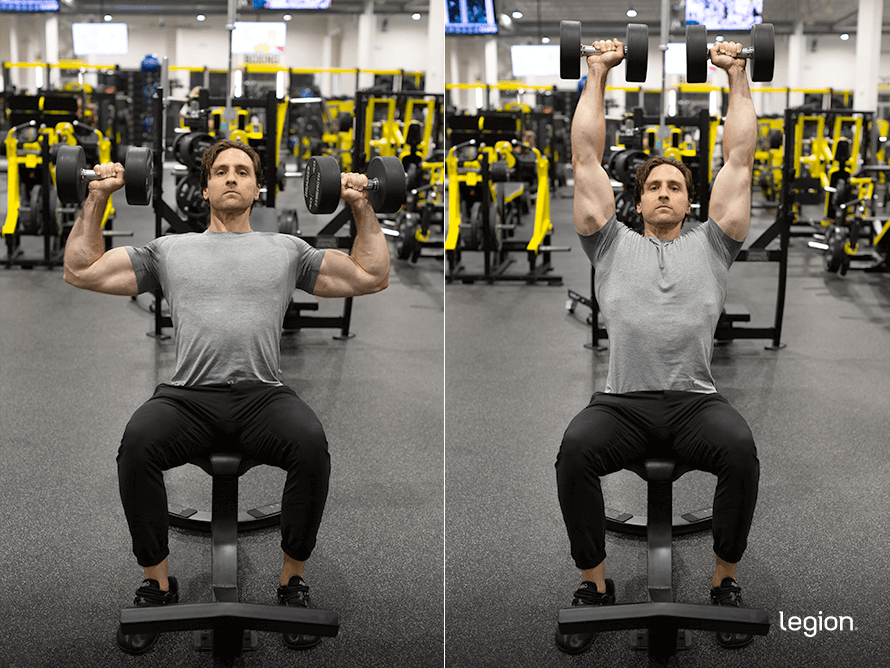
- Sit on an upright bench and hold a dumbbell in each hand, resting them on your thighs.
- Hoist the dumbbells to shoulder height with your palms facing forward.
- Press them overhead until your arms are straight.
- Lower the dumbbells and return to the starting position.
Muscles Worked: Deltoids, triceps, traps.
Alternatives:
- Standing dumbbell shoulder press
- Seated overhead press
- Arnold press
One-Arm Dumbbell Row
The one-arm dumbbell row lets you train each side of your body independently, which helps you build balanced size and strength. Because you brace against a bench, it also spares your lower back, which will already be fatigued from deadlifting.
A quick tip: Use lifting straps if your grip gives out before your back. They make holding onto the weight significantly easier, allowing you to train with heavy loads without your grip becoming the limiting factor.
How to Do the One-Arm Dumbbell Row:
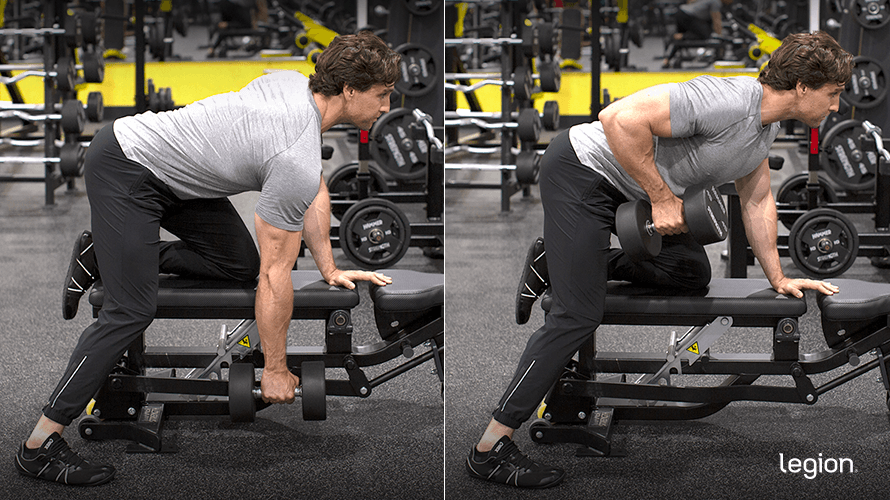
- Hold a dumbbell in your right hand and place your left knee and hand on a bench.
- Keep your right foot on the floor and let your right arm hang straight down.
- With your back flat, pull the dumbbell to your torso.
- Reverse the movement and return to the starting position.
- After completing the desired number of reps, repeat on your left side.
Muscles Worked: Lats, traps, rhomboids, teres major, rear delts, biceps.
Alternatives:
Barbell Upright Row
Many gymgoers avoid the upright row because they’ve heard it’s bad for your shoulders, but research shows it’s perfectly safe if you keep the bar close to your body and stop when your upper arms are about parallel to the floor.
When you do it like this, the upright row effectively trains your side and rear delts and upper traps, helping your shoulders develop evenly while adding width and “frame” to your upper body.
How to Do the Barbell Upright Row:
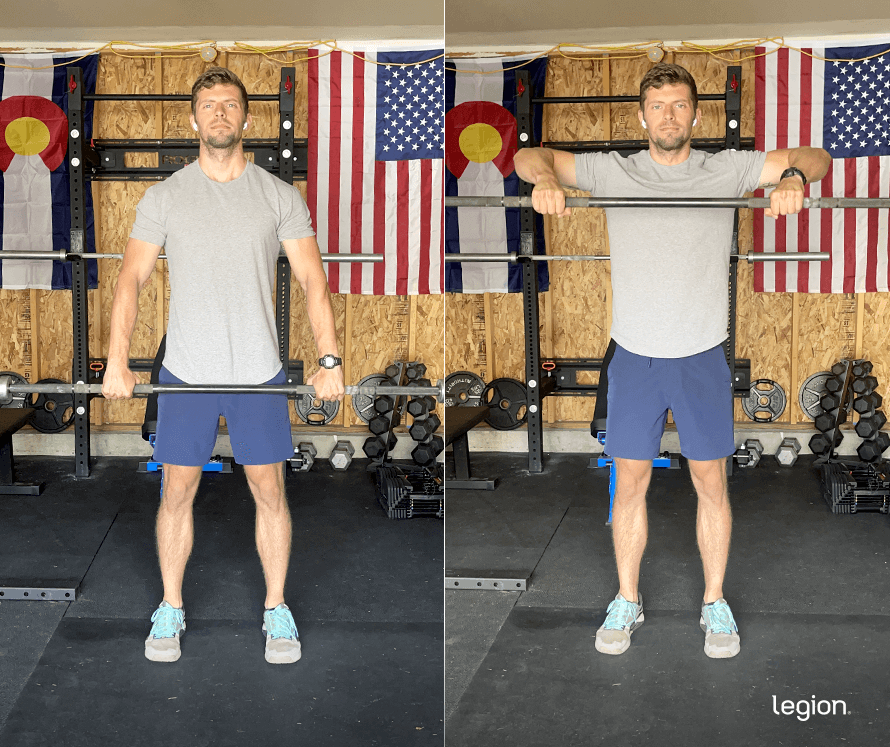
- Stand upright holding a barbell in front of your thighs with your palms facing you.
- Pull the bar up until your upper arms are parallel to the floor, keeping your elbows above your forearms.
- Lower the bar back to the starting position.
Muscles Worked: Side and rear delts, traps, biceps.
Alternatives:
- Dumbbell upright row
- Dumbbell side lateral raise
- Cable side lateral raise
Overhead Press
The overhead press is the perfect way to begin the shoulder-focused workout because—like the deadlift—it lets you lift heavy weights safely while training multiple major muscle groups at once.
It primarily targets your shoulders—especially the front and side delts—but also heavily engages your upper back, triceps, and core, making it one of the best exercises for overall upper-body development.
And because it’s a barbell movement that recruits so much muscle mass, it’s easy to apply progressive overload, so it’s perfect for driving long-term gains in both size and strength.
How to Do the Overhead Press:
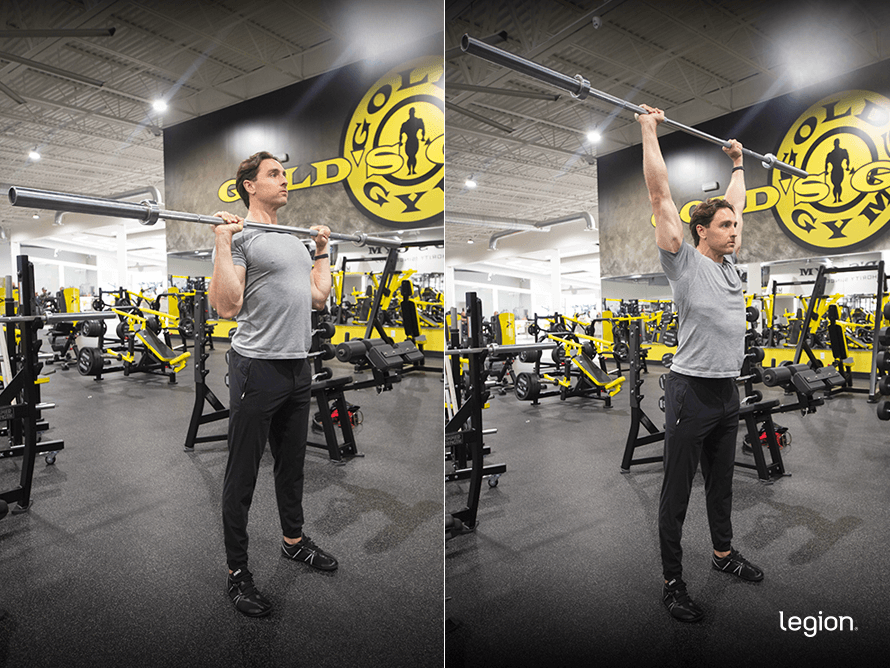
- Set a barbell in a rack at collarbone height and grip it at shoulder width with your palms facing forward.
- Unrack the barbell, step backward, and stand with your feet just outside shoulder width.
- Press the bar overhead until your arms are straight.
- Reverse the movement and return to the starting position.
Muscles Worked: Deltoids, triceps, traps.
Alternative:
- Seated overhead press
- Standing shoulder press
- Arnold press
Pull-up
The pull-up is a top-tier back exercise that’s especially effective for developing your lats, which play a big role in creating the “V-taper” many people want.
In the Legion back and shoulder workout routine, you’ll be doing sets of 4–6 reps. Once you hit the top of this range for a set using your body weight, start adding resistance by attaching plates to a dip belt or holding a dumbbell between your thighs or ankles.
This allows you to keep overloading your muscles when your body weight is no longer heavy enough.
How to Do the Pull-up:
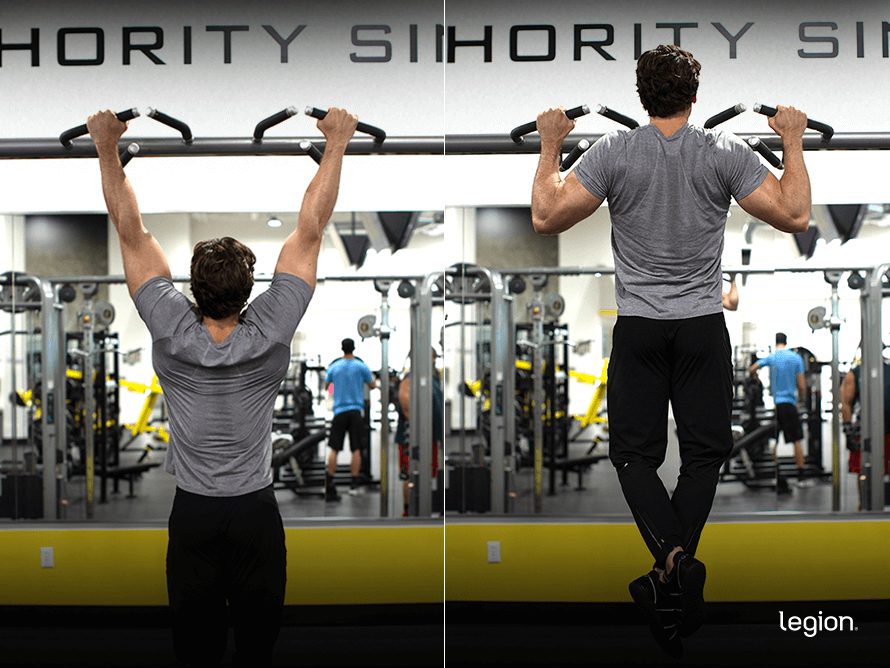
- Grab a pull-up bar slightly wider than shoulder-width apart with your palms facing away from you.
- Lift your feet so that you’re hanging with your arms straight.
- Pull your body up until your chin is above the bar.
- Reverse the movements and return to the starting position.
Muscles Worked: Lats, traps, rhomboids, rear delts, teres major, biceps.
Alternatives:
Dumbbell Side Lateral Raise
If you want broad shoulders, you can’t skip the lateral raise. While overhead pressing builds most of your shoulder mass, this exercise makes the side delts “pop”—and they’re the part of your shoulders most responsible for adding width to your frame.
If you don’t like the dumbbell version, try cable lateral raises instead. They’ve become much more popular in recent years because they keep more tension on the side delts when they’re stretched, which can benefit growth.
That said, research shows both variations are similarly effective, so choose whichever you prefer.
How to Do the Dumbbell Side Lateral Raise:
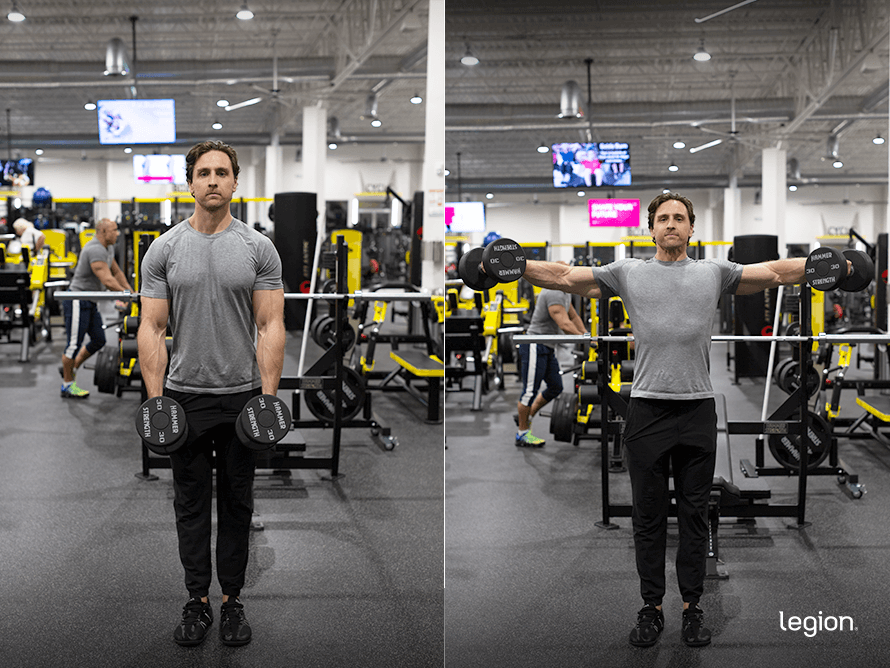
- Stand upright with a dumbbell in each hand.
- Raise them out to your sides until your upper arms are parallel to the floor.
- Reverse the movement and return to the starting position.
Muscles Worked: Side delts.
Alternatives:
- Cable side lateral raise
- Barbell upright row
- Dumbbell upright row
Seated Cable Row
The seated cable row trains nearly every muscle in your back, including your lats, traps, rhomboids, and rear delts, making it one of the best all-around rowing exercises you can do.
Using a cable also keeps constant tension on your muscles throughout each rep, which poses a different challenge than free weights. This adds variety to your workouts, which likely aids growth.
How to Do the Seated Cable Row:
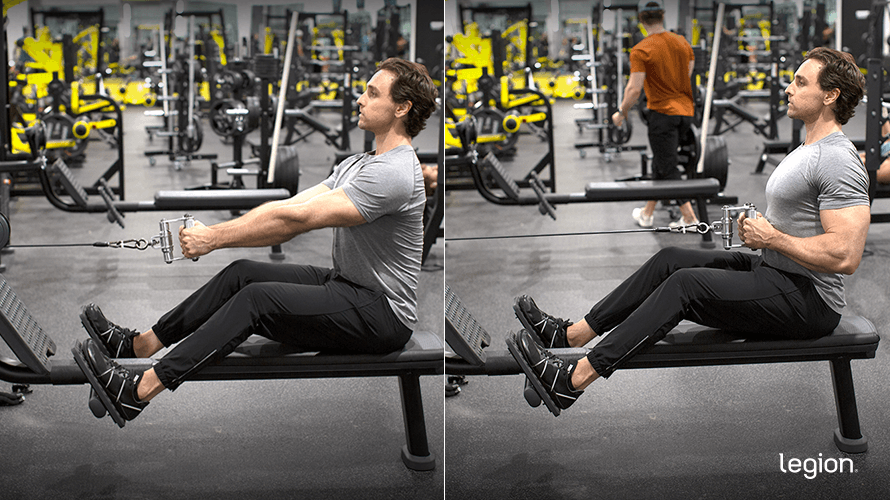
- Sit down with your feet on the footrests and your knees slightly bent.
- Grab the handle then sit upright with your arms extended in front of you.
- Pull the handle toward your stomach.
- Reverse the movement and return to the starting position.
Muscles Worked: Lats, traps, rhomboids, teres major, rear delts, biceps.
Alternatives:
- Barbell row
- T-bar row
- Pendlay row
FAQ #1: Can I use supersets for my back and shoulder workouts?
Yes. In fact, research shows they’re a great way to save time without compromising your performance. The best option is antagonist supersets, where you alternate between exercises that train opposing muscle groups.
For example, in Back and Shoulder Workout #1 above, you could do a set of one-arm dumbbell rows, then a set of upright rows, rest 2–3 minutes, and repeat.
Importantly, you should avoid using supersets for the first two exercises in each workout—the deadlift and seated shoulder press in Workout #1, and the overhead press and pull-up in Workout #2. These exercises are too demanding to superset.
As Dr. Eric Helms, Ph.D., explains in The Muscle & Strength Pyramids: Training:
“ . . . movements that require full-body effort generate local fatigue in many muscle groups at once and also generate a lot of cardiovascular stress that can leave you winded. Therefore, for “full-body exercises” . . . it’s a good idea to simply rest between sets without doing anything else.”
In other words, give major compound lifts your full focus, and save supersets for less fatiguing exercises later in your workouts.
FAQ #2: What’s a good shoulder and back workout for females?
The routine in this article works just as well for women as it does for men. The only thing you might want to revise is the rep ranges.
While everyone’s different, many women prefer slightly higher reps because they feel more manageable and less intimidating than lower-rep, heavier sets.
If that’s you, stick to the 8–10 range instead of 4–6 or 6–8.
FAQ #3: Can you do a back and shoulder dumbbell workout?
Yes, and it can be highly effective. Here’s a simple, well-rounded routine that trains every major muscle in your back and shoulders using just dumbbells:
- Standing Dumbbell Shoulder Press: 3–5 sets | 6–8 reps | 3–5 min rest
- One-Arm Dumbbell Row: 3–5 sets | 6–8 reps | 3–5 min rest
- Dumbbell Side Lateral Raise: 3–5 sets | 6–8 reps | 3–5 min rest
- Dumbbell Pullover: 3–5 sets | 6–8 reps | 3–5 min rest
If you want to train these muscle groups more than once per week, simply repeat the same workout or change the exercise order to emphasize your back. For example, start with the dumbbell row, then move to the shoulder press, pullover, and lateral raise.
Want More Content Like This?
Check out these articles:
- The Best Dumbbell Shoulder Exercises & Workouts for Mass
- The Best Cable Back Workouts and Exercises for a Wide Back
- Cable Shoulder Workouts & Exercises for Size & Strength
- How to Get Bigger and Stronger Shoulders in Just 30 Days
- How to Get a Bigger and Stronger Back in Just 30 Days
Scientific References +
- Kubo, Keitaro, et al. “Effects of Squat Training with Different Depths on Lower Limb Muscle Volumes.” European Journal of Applied Physiology, vol. 119, no. 9, 22 June 2019, https://doi.org/10.1007/s00421-019-04181-y.
- “View of the Resistance Training Dose-Response: Meta-Regressions Exploring the Effects of Weekly Volume and Frequency on Muscle Hypertrophy and Strength Gain.” Sportrxiv.org, 2024, sportrxiv.org/index.php/server/preprint/view/460/967.
- “Set Volume for Muscle Size: The Ultimate Evidence Based Bible.” Weightology, weightology.net/the-members-area/evidence-based-guides/set-volume-for-muscle-size-the-ultimate-evidence-based-bible/.
- Eckerson, Joan M., et al. “Effect of Creatine Phosphate Supplementation on Anaerobic Working Capacity and Body Weight after Two and Six Days of Loading in Men and Women.” The Journal of Strength and Conditioning Research, vol. 19, no. 4, 2005, p. 756, https://doi.org/10.1519/r-16924.1.
- Bassit, Reinaldo Abunasser, et al. “Effect of Short-Term Creatine Supplementation on Markers of Skeletal Muscle Damage after Strenuous Contractile Activity.” European Journal of Applied Physiology, vol. 108, no. 5, 3 Dec. 2009, pp. 945–955, https://doi.org/10.1007/s00421-009-1305-1.
- Schoenfeld, Brad, et al. “The Upright Row: Implications for Preventing Subacromial Impingement.” Strength & Conditioning Journal, vol. 33, no. 5, Oct. 2011, pp. 25–28, https://doi.org/10.1519/ssc.0b013e31822ec3e3. Accessed 13 Sept. 2021.
- McAllister, Matthew J., et al. “Effect of Grip Width on Electromyographic Activity during the Upright Row.” The Journal of Strength & Conditioning Research, vol. 27, no. 1, 1 Jan. 2013, pp. 181–187, journals.lww.com/nsca-jscr/Fulltext/2013/01000/Effect_of_Grip_Width_on_Electromyographic_Activity.25.aspx, https://doi.org/10.1519/JSC.0b013e31824f23ad.
- Youdas, James W, et al. “Surface Electromyographic Activation Patterns and Elbow Joint Motion during a Pull-Up, Chin-Up, or Perfect-PullupTM Rotational Exercise.” Journal of Strength and Conditioning Research, vol. 24, no. 12, Dec. 2010, pp. 3404–3414, https://doi.org/10.1519/jsc.0b013e3181f1598c.
- Larsen Stian, et al. Dumbbell versus Cable Lateral Raises for Lateral Deltoid Hypertrophy: An Experimental Study. 17 Dec. 2024, sportrxiv.org/index.php/server/preprint/view/487, https://doi.org/10.51224/srxiv.487.
- HANDA, TOHRU, et al. “COMPARATIVE ELECTROMYOGRAPHICAL INVESTIGATION of the BICEPS BRACHII, LATISSIMUS DORSI, and TRAPEZIUS MUSCLES during FIVE PULL EXERCISES.” Japanese Journal of Physical Fitness and Sports Medicine, vol. 54, no. 2, 2005, pp. 159–168, https://doi.org/10.7600/jspfsm.54.159.
- Costa, Bruna Daniella de Vasconcelos, et al. “Does Performing Different Resistance Exercises for the Same Muscle Group Induce Non-Homogeneous Hypertrophy?” International Journal of Sports Medicine, vol. 42, no. 09, 13 Jan. 2021, pp. 803–811, https://doi.org/10.1055/a-1308-3674.
- Paz, Gabriel A., et al. “Volume Load and Neuromuscular Fatigue during an Acute Bout of Agonist-Antagonist Paired-Set vs. Traditional-Set Training.” Journal of Strength and Conditioning Research, vol. 31, no. 10, Oct. 2017, pp. 2777–2784, https://doi.org/10.1519/jsc.0000000000001059.
